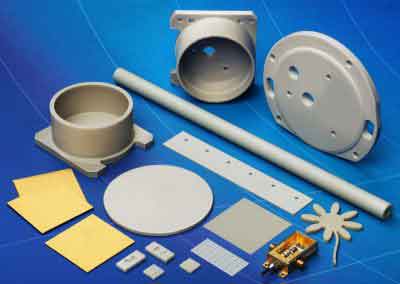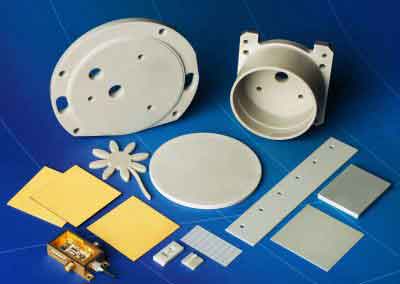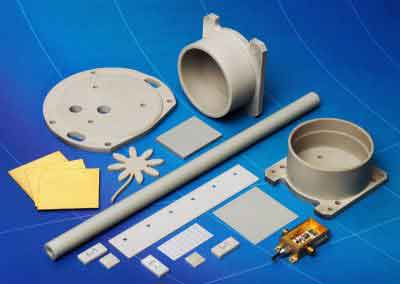Aluminum Nitride (AlN)
Aluminum Nitride (AlN) is an excellent material to use if high thermal conductivity and electrical insulation properties are required; making it an ideal material for use in thermal management and electrical applications. Additionally, Aluminum Nitride is a common alternative to Beryllium Oxide (BeO) in the semiconductor industry as it is not a health hazard when machined. Aluminum Nitride has a coefficient of thermal expansion and electrical insulation properties that closely matches that of Silicon wafer material, making it an useful material for electronics applications where high temperatures and heat dissipation is often a problem.
Aluminum Nitride Properties
Mechanical Properties
Density
Modulus of Elasticity
Fracture Toughness
Poissons Ratio
Compressive Strength
Flexural Strength
Hardness (Knoop 100g)
Hardness (Vickers)
Unit
Value
Thermal Properties
Maximum Oxidizing Temperature *
Maximum Inert Temperature
Thermal Conductivity @ 25°C
Thermal Conductivity @ 300°C
Specific Heat
Thermal Shock Resistance ΔT
** CTE 25°C ➞ 100°C
** CTE 25°C ➞ 300°C
** CTE 25°C ➞ 500°C
** CTE 25°C ➞ 1000°C
Unit
Value
* Aluminum Nitride is susceptible to surface oxidization. When this happens, a layer of Aluminum Oxide forms. This does help to protect the material, however, it impacts the thermal conductivity (Alumina is ~30 W/m.K). In oxidizing atmospheres, this happens around 700°C. In inert atmospheres this layer protects the AlN up to ~1350°C. Bulk oxidation will occur at temperatures above this.
** Coefficient of Thermal Expansion (CTE) describes how the size of an object changes with a change in temperature.
Electrical Properties
Dielectric Constant
Loss Tangent
Dielectric Strength
Volume Resistivity @ 25°C
Volume Resistivity @ 300°C
Volume Resistivity @ 500°C
Unit
Value
Related Materials
Aluminum Nitride is one of the few materials that offers electrical insulation and high thermal conductivity. This makes AlN extremely useful in high power electronic applications in heat sink and heat spreader applications. Other materials that are commonly used are boron nitride, Shapal Hi-M Soft, beryllium oxide, and sometimes alumina.
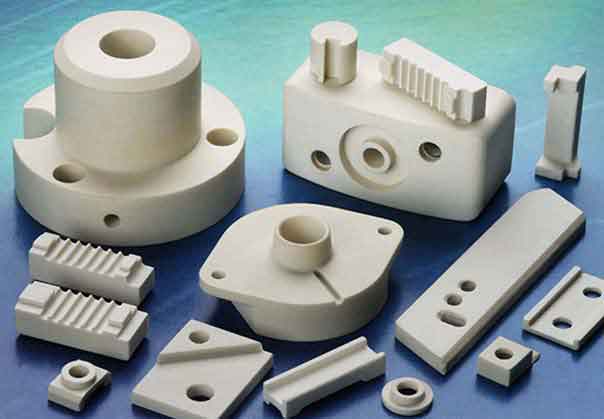
Shapal Hi-M Soft
Shapal Hi-M Soft is a hybrid type of machinable Aluminum Nitride (AlN) ceramic that offers high mechanical strength and thermal conductivity.
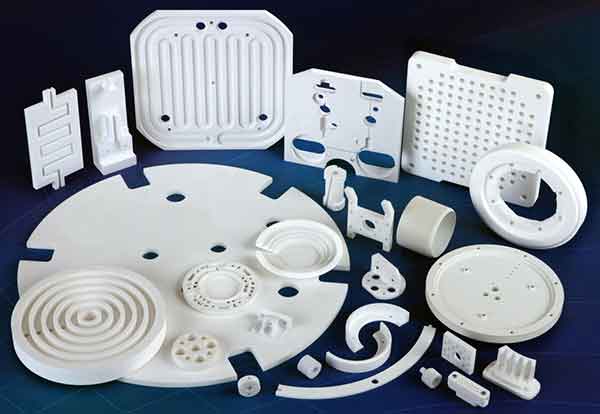
Boron Nitride
Boron Nitride (BN) is an advanced synthetic ceramic material available in solid and powder form. It has outstanding thermal conductivity and is easy to machine.
Aluminum Nitride Manufacturing
China Ceramic Parts is your Aluminum Nitride machining specialist for your technical ceramic prototyping & manufacturing needs; we are always happy to use our many years of advanced ceramics experience to provide advice on materials, design, and application. If you would like to buy Aluminum Nitride plates, rods, tubes or custom machined components, or need more information, please contact us and one of our experts will be happy to assist you.
Aluminum Nitride can be machined in green, biscuit, or fully dense states. While in the green or biscuit form it can be machined relatively easily into complex geometries. However, the sintering process that is required to fully densify the material causes the Aluminum Nitride body to shrink approximately 20%. This shrinkage means that it is impossible to hold very tight tolerances when machining Aluminum Nitride pre-sintering.
In order to achieve very tight tolerances, fully sintered material must be machined/ground with diamond tools. In this process a very precise diamond coated tool/wheel is used to abrade away the material until the desired form is created. Due to the inherent toughness and hardness of the material, this can be a time consuming and costly process. Shapal Hi-M Soft is often used as a substitute for pure AlN because it also offers high thermal conductivity, electrical insulation, and can be machined into complex geometries with tight tolerances.
AlN commonly comes in substrates up to 1 mm thick which can easily be laser cut. It can also come in thicker forms, however, it can be difficult/costly to manufacture in small quantities if the part requires custom material or significant machining. Shapal Hi-M Soft is often used as an alternative to pure aluminum nitride because it also offers high thermal conductivity and can be machined into complex geometries.
Frequently Asked Questions
- What is Aluminum Nitride?
Aluminum Nitride (AlN) is an excellent material to use if high thermal conductivity and electrical insulation properties are required; making it an ideal material for use in thermal management and electrical applications. Additionally, Aluminum Nitride is common alternative to Beryllium Oxide (BeO) in the semiconductor industry as it is not a health hazard when machined. Aluminum Nitride has a coefficient of thermal expansion and electrical insulation properties that closely matches that of Silicon wafer material, making it an useful material for electronics applications where high temperatures and heat dissipation is often a problem.
- What is Aluminum Nitride used for?
Aluminum Nitride (AlN) is an excellent material to use if high thermal conductivity and electrical insulation properties are required. Because of it’s qualities, it is an ideal material for use in thermal management and electrical applications. Some common applications of Aluminum Nitride include the following:
- Heat sinks & heat spreaders
- Electrical insulators for lasers
- Chucks, clamp rings for semiconductor processing equipment
- Electrical insulators
- Silicon wafer handling and processing
- Substrates & insulators for microelectronic devices & opto electronic devices
- Substrates for electronic packages
- Chip carriers for sensors and detectors
- Chiplets
- Collets
- Laser heat management components
- Molten metal fixtures
- Packages for microwave devices
- Is Aluminum Nitride a ceramic?
Aluminum nitride (AlN) is a technical ceramic material that features an extremely interesting combination of very high thermal conductivity and excellent electrical insulation properties.
- Is Aluminum Nitride toxic?
Exposure to AlN through mouth, inhalation, or injection may cause bone and lung toxicity. Repeated exposure can irritate the eyes and skin.

